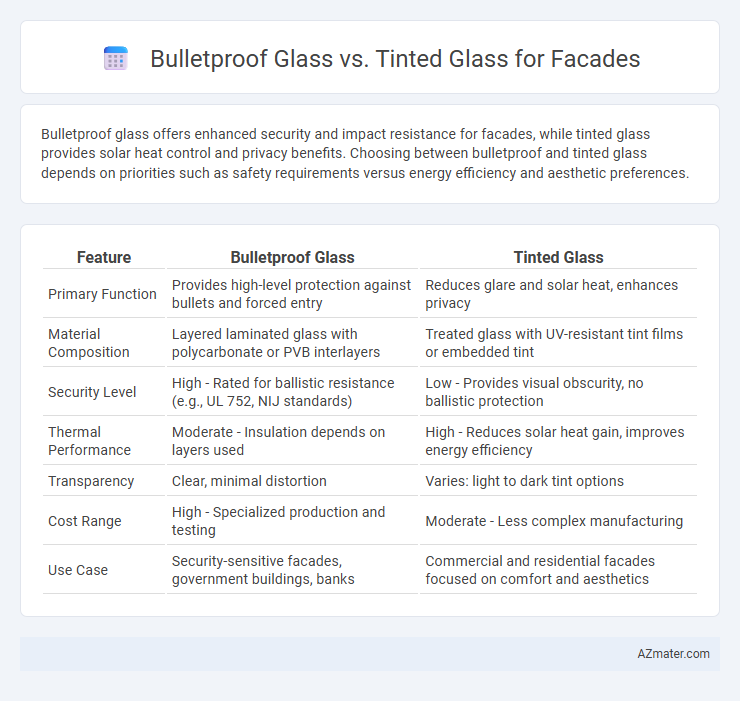Bulletproof glass offers enhanced security and impact resistance for facades, while tinted glass provides solar heat control and privacy benefits. Choosing between bulletproof and tinted glass depends on priorities such as safety requirements versus energy efficiency and aesthetic preferences.
Table of Comparison
| Feature | Bulletproof Glass | Tinted Glass |
|---|---|---|
| Primary Function | Provides high-level protection against bullets and forced entry | Reduces glare and solar heat, enhances privacy |
| Material Composition | Layered laminated glass with polycarbonate or PVB interlayers | Treated glass with UV-resistant tint films or embedded tint |
| Security Level | High - Rated for ballistic resistance (e.g., UL 752, NIJ standards) | Low - Provides visual obscurity, no ballistic protection |
| Thermal Performance | Moderate - Insulation depends on layers used | High - Reduces solar heat gain, improves energy efficiency |
| Transparency | Clear, minimal distortion | Varies: light to dark tint options |
| Cost Range | High - Specialized production and testing | Moderate - Less complex manufacturing |
| Use Case | Security-sensitive facades, government buildings, banks | Commercial and residential facades focused on comfort and aesthetics |
Introduction to Facade Glass Options
Facade glass options include bulletproof glass and tinted glass, each serving distinct functional and aesthetic purposes. Bulletproof glass offers enhanced security by resisting penetration from projectiles, making it ideal for high-risk buildings and government facilities. Tinted glass reduces solar heat gain and glare, improving energy efficiency while providing privacy and a sleek exterior appearance for commercial and residential facades.
Understanding Bulletproof Glass
Bulletproof glass, also known as ballistic glass, is engineered by laminating multiple layers of polycarbonate or other polymers between sheets of glass to provide high resistance against impacts and ballistic threats, making it ideal for secure facade applications. This glass type offers enhanced protection against forced entry, gunfire, and explosions, whereas tinted glass primarily focuses on reducing solar heat gain, glare, and improving privacy without providing significant security benefits. Understanding bulletproof glass's composition and testing standards such as UL 752 is critical for specifying the right level of protection in facade design.
Exploring Tinted Glass Features
Tinted glass for facades enhances energy efficiency by reducing solar heat gain and minimizing glare, making it ideal for buildings in warm climates. Its ability to filter UV rays protects interior furnishings from fading, while offering privacy without compromising natural light. Unlike bulletproof glass, which prioritizes security and impact resistance, tinted glass excels in improving comfort and aesthetic appeal in architectural applications.
Safety & Security: Bulletproof vs Tinted Glass
Bulletproof glass provides superior safety and security for facades by offering high resistance to impacts, ballistic attacks, and forced entry, making it ideal for buildings requiring maximum protection. Tinted glass enhances privacy and reduces glare and solar heat gain but does not offer significant protection against break-ins or violent impacts. For secure facades, bulletproof glass ensures enhanced durability and occupant safety beyond the aesthetic and energy-saving benefits of tinted glass.
Aesthetics and Visual Appeal
Bulletproof glass offers a sleek, seamless appearance with a high level of transparency that enhances natural light and creates an open, modern facade without visual distortion. Tinted glass adds aesthetic value by reducing glare and providing a variety of color options, enabling customized visual effects and improved exterior harmony. Both types complement architectural design, with bulletproof glass emphasizing clarity and security while tinted glass focuses on energy efficiency and style.
Energy Efficiency and Sun Control
Bulletproof glass offers superior security with minimal impact on energy efficiency, but it typically lacks the reflective and heat-reducing properties of tinted glass. Tinted glass enhances sun control by reducing solar heat gain and glare, significantly lowering cooling costs in facade applications. Combining both technologies can optimize energy savings while maintaining safety and aesthetic appeal.
Cost Comparison: Bulletproof vs Tinted Facade Glass
Bulletproof glass for facades typically costs between $50 to $100 per square foot due to its multi-layered construction and high-strength materials, making it a significant investment compared to tinted glass, which averages $15 to $40 per square foot. The installation expenses for bulletproof glass are also higher owing to its weight and specialized mounting requirements, whereas tinted glass installation is more straightforward and less labor-intensive. Long-term cost factors include maintenance and replacement, where bulletproof glass offers enhanced durability and security benefits, potentially reducing indirect costs compared to tinted glass.
Installation & Maintenance Considerations
Bulletproof glass for facades requires precise installation by certified professionals to ensure structural integrity and optimal impact resistance, often involving specialized framing systems to handle its weight and thickness. Tinted glass installation is generally simpler, compatible with standard glazing systems, and primarily focuses on achieving uniform color and solar control properties. Maintenance of bulletproof glass involves regular inspections for micro-cracks and maintaining seals to preserve ballistic resistance, while tinted glass requires routine cleaning to avoid film degradation and fading from UV exposure.
Applications in Commercial and Residential Buildings
Bulletproof glass offers enhanced security by providing resistance to ballistic impacts, making it ideal for commercial buildings such as banks, government offices, and high-risk retail stores requiring protection against break-ins or attacks. Tinted glass, commonly used in both commercial and residential facades, improves energy efficiency by reducing solar heat gain and glare while enhancing privacy without compromising natural light. Combining bulletproof and tinted glass technologies is increasingly favored in upscale residential projects and secure commercial facilities, balancing safety, aesthetics, and environmental performance.
Choosing the Right Glass for Your Facade
Selecting between bulletproof glass and tinted glass for your facade depends on the primary security and aesthetic goals of your building. Bulletproof glass offers superior protection against forced entry and ballistic threats, making it ideal for high-security facilities, while tinted glass enhances energy efficiency, reduces glare, and provides privacy by controlling solar heat gain and UV exposure. Evaluating factors such as safety requirements, climate conditions, and design preferences ensures the optimal glass choice for both function and appearance in your facade solution.

Infographic: Bulletproof glass vs Tinted glass for Facade
 azmater.com
azmater.com